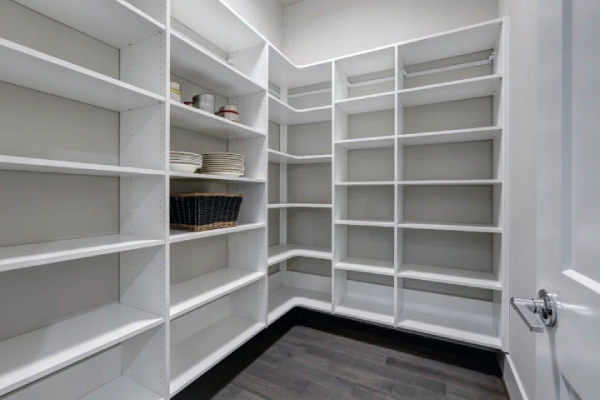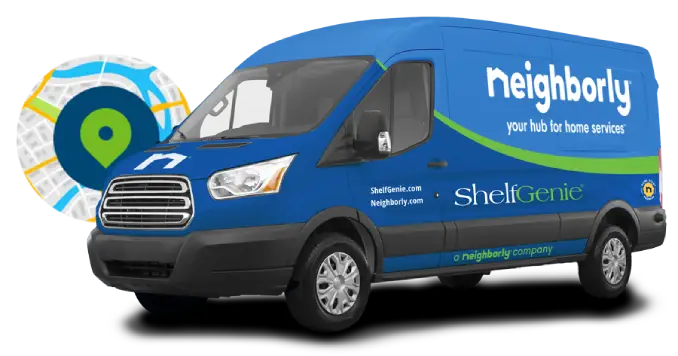
Pantry storage can be hard to come by, whether you’re feeding a large family, working with a small space, or navigating a combination of both. As a result, snacks, kitchen essentials, cookware, and your ever-expanding collection of measuring cups can look like a jumbled mess at the end of a long day. And, if you’re not careful, you could knock over pantry items and create more of a mess for yourself.
Fortunately, you don’t necessarily need to redo your entire pantry to get more storage space. Building pantry shelves can provide you with additional storage within your existing layout. Plus, sturdy wood pantry shelving may offer enhanced durability and aesthetic appeal compared to plastic storage shelves.
But is wood pantry shelving right for your space, and is it simple enough for a DIYer to install? With a little research — and the right materials — you can maximize storage space and create the functional pantry you’ve always wanted.
How To Choose the Best Wood for Building Pantry Shelves
Like any project, establishing a firm foundation is the first step — and the best way to ensure longevity. This can be especially true when it comes to storage upgrades like wood pantry shelving.
Take some time to consider your options when choosing the best wood for your pantry shelves. Engineered or particle boards are often used for DIY jobs like these. However, budgeting for premium options like cedar, cherry, or walnut can eliminate some post-installation work required to achieve that pro finish on your shelving, like sanding the edges, messing with iron-on tape, or applying a stain.
Materials and Tools for Your DIY Pantry Shelving Project
Before you empty your pantry and break out your saw to rough out your shelving, take some time to gather your materials:
- A measuring tape
- A saw (circular or table saw, or a miter saw if you plan to build corner shelves)
- A level
- A hammer or nailer
- A stud finder
- Paint or stain if needed
- Protective gear, including a mask and eyewear
Every pantry shelving installation project is unique, but you’ll likely need to source materials for a frame and front trim for your shelving boards, too.
Frame
A shelf frame supports a shelf in a pantry. The frame is usually made of wood or metal and designed to hold a lot of weight. It’s also responsible for evenly distributing the weight of the items stored on the shelves so they don’t sag or — worse — collapse.
With that in mind, consider a sturdy hardwood or metal frame to ensure a long-lasting shelf. Take the time to map out your shelving design to ensure there’s room for additional storage features like Pull-Out shelves and baskets, drawers, spice racks, and more.
Shelf
No one wants to spend time and money building pantry shelves only to see them sag under the weight of heavy items. Set yourself — and your shelves — up for success by considering the following details when choosing a wood for your pantry:
1. Durability: Pantry shelves hold heavy cans, boxes, and even appliances. Look for strong and resilient woods, such as oak, maple, cherry, and mahogany.
2. Stability: Opt for tight-grained woods like maple or birch to prevent your shelves from warping or sagging.
3. Maintenance: Certain woods require regular sealing or refinishing to maintain their durability. Others may only require a wipe-down every few months. It is important to know what kind of maintenance you are getting into when choosing wood for your pantry shelves.
4. Moisture: Pantries storing perishables can be a breeding ground for moisture and humidity. It's advisable to choose a wood species that is more resistant to moisture, like cedar, cherry, or cypress.
5. Budget: Hardwoods are usually more expensive than softwoods. When choosing a material for your shelves, be sure to factor in the cost of the wood and any finishing required.
Front Trim
Finally, determine whether you want to finish your shelving with front trim. It’s not necessary, especially if you prefer a raw, rougher-hewn edge or the ever-popular rustic farmhouse look. However, if you prefer a cleaner finish, you may choose options like wood trim, medium-density fiberboard (MDF), or polyvinyl chloride (PVC) to trim your shelves. You could also opt for a metal trim to add a sleek, modern finish.
Types of Wood for Pantry Shelves
When building pantry shelves, there are five main types of wood to consider using:
- Hardwood (or high-quality softwood)
- High-grade wood
- Non-defective wood (without loose knots)
- Solid wood (those having no particle boards)
- Wood alternatives
Your final wood option may depend largely on the type of pantry cabinets you want to have and the way they’re designed. For instance, some pantry cabinets are built to be stationary, while some are designed to be moveable so they can rotate and stack. Other pantry shelf options range from shallow nooks to deep-set shelves placed on sliders and pull-out columns and racks. Ultimately, the wood that's chosen for the pantry shelf will impact the cost as well as the design of the project.
1. Pinewood
The pine tree is a staple of North America. So, if you decide to use pinewood, you’ll likely have no trouble finding it.
Pine is one of the most popular softwoods. It's ideal for beginner DIY enthusiasts learning to build their wooden projects. Pinewood is great for kitchen pantries, particularly if the shelves aren’t used to storing heavy items. Pinewood also provides great versatility and flexibility, which allows users to pick up any size or grade to work with.
Although pine is an affordable solid wood, it tends to be easily damaged. It’s also susceptible to scratches and dents. So, this may not be the ideal wood to use if your goal is to build a high-end pantry.
2. Western Red Cedar
Popular in the Pacific Northwest region of the United States, the western red cedar is an impressive tree. It also produces some of the best softwood.
Although it’s generally advised to use hardwood over softwood in building shelves, in this case, one may gladly make an exception. This is because the growth pattern of the western red cedar makes it an invaluable asset for shelving both inside and outside the home.
The western red cedar has a soft red tint that distinguishes it from redwood, giving it a distinct shade of its own. This sturdy softwood option provides elegance and adequate stress tolerance in one package.
3. Cherry

Homeowners choose cherry above other types of hardwood for pantry shelves because of its warm, rich, reddish color.
Its unique hue gets even better with time, becoming darker and richer as it ages. This gives it a distinctive sheen. Old shelves built from cherry wood are very sought-after antique collector’s items.
4. Red Oak
Red oak’s sturdiness makes it another popular wood for building shelves. You’ll encounter no difficulty cutting, handling, and finishing this type of wood.
Because red oak is easy to work with, it’s often preferred by those who want to build their pantry shelves themselves.
5. Walnut
Walnut is a classic hardwood that never runs out of style. The best part is that it requires no further paintwork or treatment to look impressive.
But walnut wood isn’t easy to find and doesn’t come cheap. If you’re able to stomach the cost, you’ll be rewarded with its unique depth and grain all its own.
Walnut isn’t necessarily the most cost-effective option, but a high-grade walnut will provide you with a sturdy pantry shelf that will serve you for many years to come.
6. Mahogany
Mahogany is the type of wood that exudes excellence and charm. Its classic charm makes it a frequent part of the decor used for shelves found in offices, libraries, and other formal places.
If you’re smitten by its beauty, nothing prevents you from using it to build your pantry shelf. Considering that mahogany is a hardwood, it doesn’t make it the best option for inexperienced builders.
7. Wood Alternatives
As a general rule of thumb, natural hardwood may offer the most durability and long-term appeal for your pantry shelves. However, there are some sturdy wood alternatives you may consider, too. Durable, inexpensive MDF is a great option for those looking for additional storage on a budget. At the same time, bamboo and some engineered woods provide enough durability and moisture resistance to keep your pantry ready to hold your items for years to come.
Woods to Avoid When Building Pantry Shelves
It’s generally best to avoid woods that don’t provide long-term rigidity. Also, steer clear of those that need a lot of extra support over the long haul and easily sag under a lot of weight. If the wood has poorly graded sides or knots or is rough-hewn, you may want to consider alternatives. These properties usually make them difficult to finish and paint. Finally, it’s a good idea to avoid particle boards and other lightweight engineered boards, as these may sag or split over time.
Consider Installing Custom Pull-Out Pantry Shelves
New wooden pantry shelving is a worthy investment but building pantry shelves isn’t always an easy job — especially when you’re short on time. Fortunately, our team at ShelfGenie® can help. Our experienced designers have the skills and expertise needed to create a fully customized, beautifully functional Pull-Out pantry shelving for you, then install it quickly and professionally so you can focus on whipping up delicious meals with your family rather than worrying about finding the best wood for pantry shelves or cutting perfect corners with a miter saw.
What’s more, our three-step process ensures a convenient storage solution tailored to your needs, with every installation backed by our Neighborly Done Right Promise™. Ready to upgrade your pantry? Find a ShelfGenie location near you or book a free consultation online to get started today.
